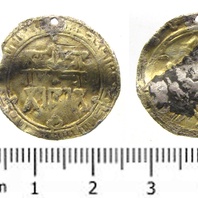
Viking Objects
Samanid Silver Dirham Pendant (LCNCC:2014.16)
An Arabic silver dirham minted c. 905-906 (Hijra 293) for the Samanid ruler, Isma’il ibn Ahmad (849-907), that has subsequently been pierced and gilded so that it could be worn as a pendant. It was probably minted in Balkh, Afghanistan. The Vikings often repurposed items like this. The dirham was a unit of weight used across North Africa, the Middle East, and Persia, with varying values which also referred to the type of coins used in the Middle East during the Viking Age. These coins were extremely prized possessions not only for their silver value but as a way of displaying one’s wealth and vast trade connections. Millions of Arabic dirhams would have been imported throughout the Viking world and are mostly found in hoards.
Read More
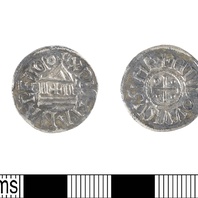
Viking Objects
Carolingian Denier (LIN-F6C6E1)
A Carolingian silver denier issued by Louis the Pious and classified as a Christiana Religio type, which was his third and last coinage. It is possible that it made its way to England prior to Viking incursions but it is equally likely that the Vikings brought this coin with them as plunder after raiding in Frankia.
Read More
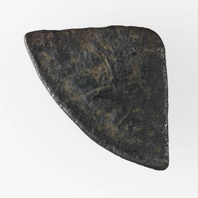
Viking Objects
Unprovenanced Abbasid Silver Dirham (CM_1777_2008)
It is unknown for which ruler this dirham was minted nor where the mint was located. However, it has been speculated that the mint would have been located somewhere in Iraq, Iran, or Central Asia. The dirham was a unit of weight used across North Africa, the Middle East, and Persia, with varying values which also referred to the type of coins used in the Middle East during the Viking Age. These coins were extremely prized possessions not only for their silver value but as a way of displaying one’s wealth and vast trade connections. Millions of Arabic dirhams would have been imported throughout the Viking world and are mostly found in hoards. It is thought that one cause of the Viking Age was a reduction in access to Arabic silver.
Read More
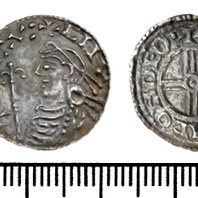
Viking Objects
Coin of Cnut the Great (LEIC-4B7888)
This Short Cross Type silver penny was minted in the name of King Cnut between 1024 and 1030 in the Derby mint by the moneyer Swartinc. The location of discovery is unknown. Minting coins was a way of controlling the means of exchange within a kingdom and which created a more easily administered standardized system of trade. Moreover, the coins themselves were often used as propaganda, portaying symbols and statements that gave off a desired message. The Vikings later used the minting of coins to legitimize their own rule.
Read More
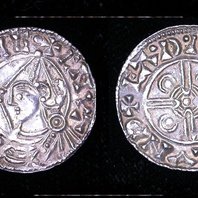
Viking Objects
Coin of Cnut the Great (LEIC-3E8CC4)
This silver Helmet IIIc Type penny was minted for King Cnut of England in London. The obverse inscription reads CNVTREXANG while the obverse reads EADPOLD ON LVND. Minting coins was a way of controlling the means of exchange within a kingdom and which created a more easily administered standardized system of trade. Moreover, the coins themselves were often used as propaganda, portaying symbols and statements that gave off a desired message. The Vikings later used the minting of coins to legitimize their own rule.
Read More
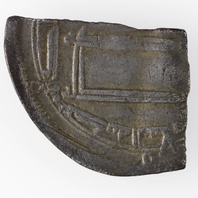
Viking Objects
Abbasid Silver Dirham (CM_773_2008)
This coin was minted at al-‘Abbasiyya. The dirham was a unit of weight used across North Africa, the Middle East, and Persia, with varying values which also referred to the type of coins used in the Middle East during the Viking Age. These coins were extremely prized possessions not only for their silver value but as a way of displaying ones wealth and vast trade connections. Millions of Arabic Dirhams would have been imported throughout the Viking world and are mostly found in hoards. Reduction in access to silver coins like this is thought to have been one of the causes of the Viking Age.
Read More
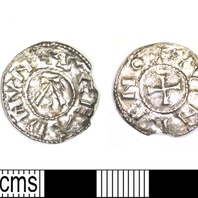
Viking Objects
St Edmund Penny (LEIC-4FC58C)
Between 895 and 915, Scandinavian settlers in East Anglia minted a series of pennies and half pennies with the inscription SCE EADMVND REX (St Edmund the king). These coins appear to have been used widely throughout the Danelaw, and a large number of them were discovered in the Cuerdale Hoard from Lancashire. This coin appears to have been made with a poorly engraved die and features a blundered inscription naming the moneyer. The Portable Antiquities Scheme suggests that the moneyer’s name was Winegar. The inscription reads YVINRE NO.
Read More
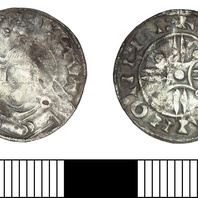
Viking Objects
Coin of Cnut the Great (DENO-28F8A6)
This silver penny is a posthumous issue of Cnut, with arm and sceptre obverse type, minted by Thurgrim in Lincoln under the authority of King Harthacnut. Minting coins was a way of controlling the means of exchange within a kingdom and which created a more easily administered standardized system of trade. Moreover, the coins themselves were often used as propaganda, portaying symbols and statements that gave off a desired message. The Vikings later used the minting of coins to legitimize their own rule.
Read More
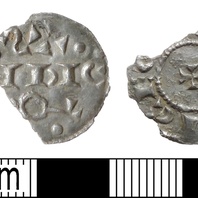
Viking Objects
Incomplete Viking Silver Penny (DENO-7A0AF7)
An incomplete silver early medieval penny of the Vikings influenced by the Swordless St Peter type and possibly minted in the name of Sihtric Caoch who ruled Dublin between 917-920 CE and was King of Northumbria from 921-927 CE. It is not certain why he left Ireland. The Irish annals state that it was ‘through the grace of God’ and do not elaborate on the politics behind his departure. After the establishment of the Danelaw, some Viking leaders decided to mint their own coins to solidify their legitimacy in the eyes of the local populace. This created a hybrid economy where some members of the Danelaw used bullion and others used coins.
Read More
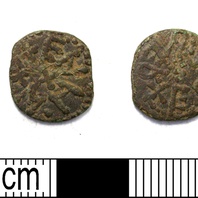
Viking Objects
Northumbrian Styca (LEIC-0D9D6F)
This Northumbrian styca was probably minted in the name of Æthelred II of Northumbria possibly by the moneyer Eanwulf. While Wessex and Mercia were using silver coinage as part of their monetary economy, Northumbria was using copper coins known as stycas, which may have contained trace amounts of silver. The concentration of these coins at sites such as Torksey and ARSNY (‘a riverine site near York’) suggests that they could have remained in circulation after the fall of Northumbria in 866 but were taken to these sites by the Vikings during their campaigning. This particular example was likely brought to Nottinghamshire from Northumbria by means of the Great Army’s overwintering activities in and around Nottingham.
